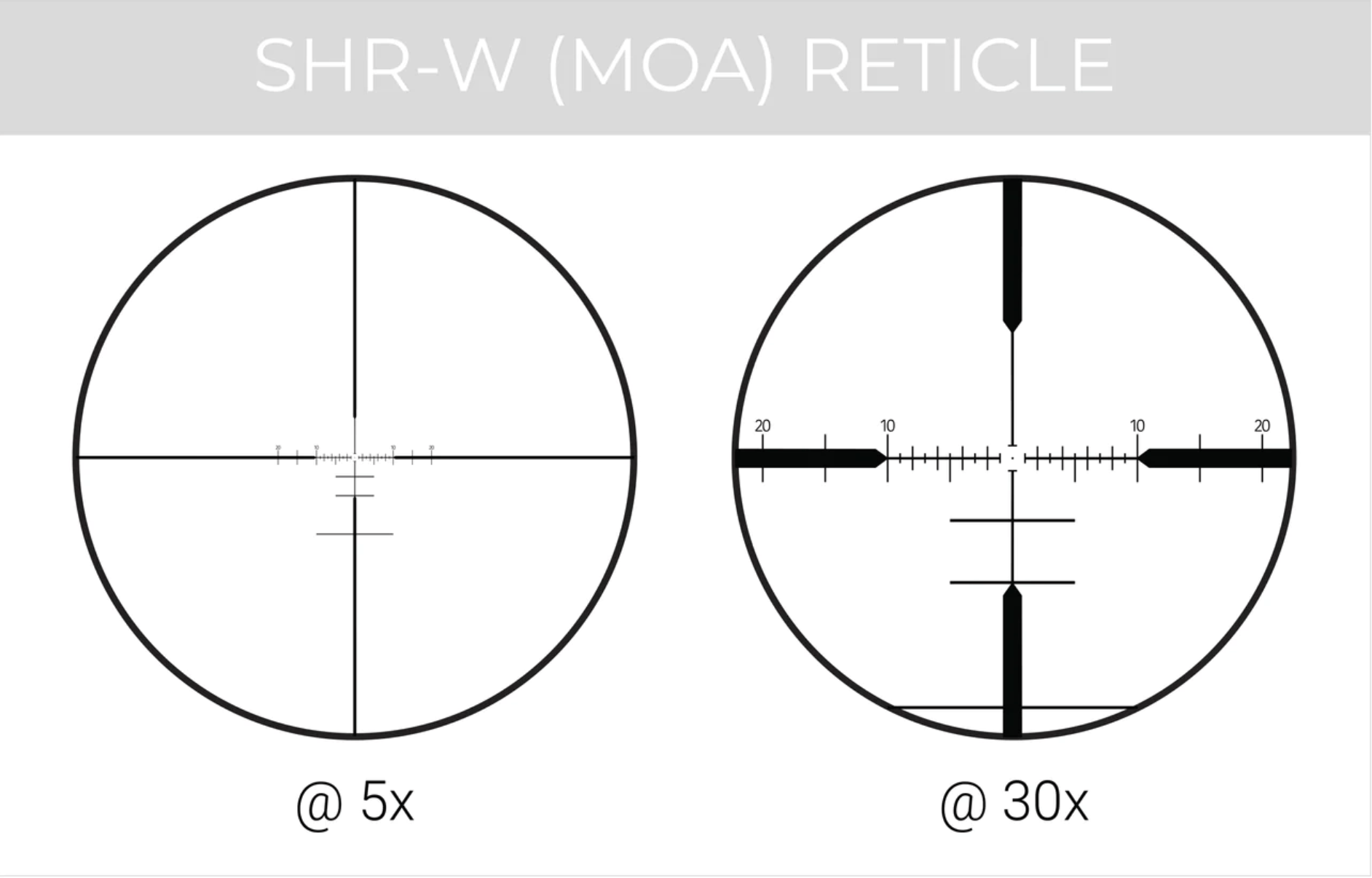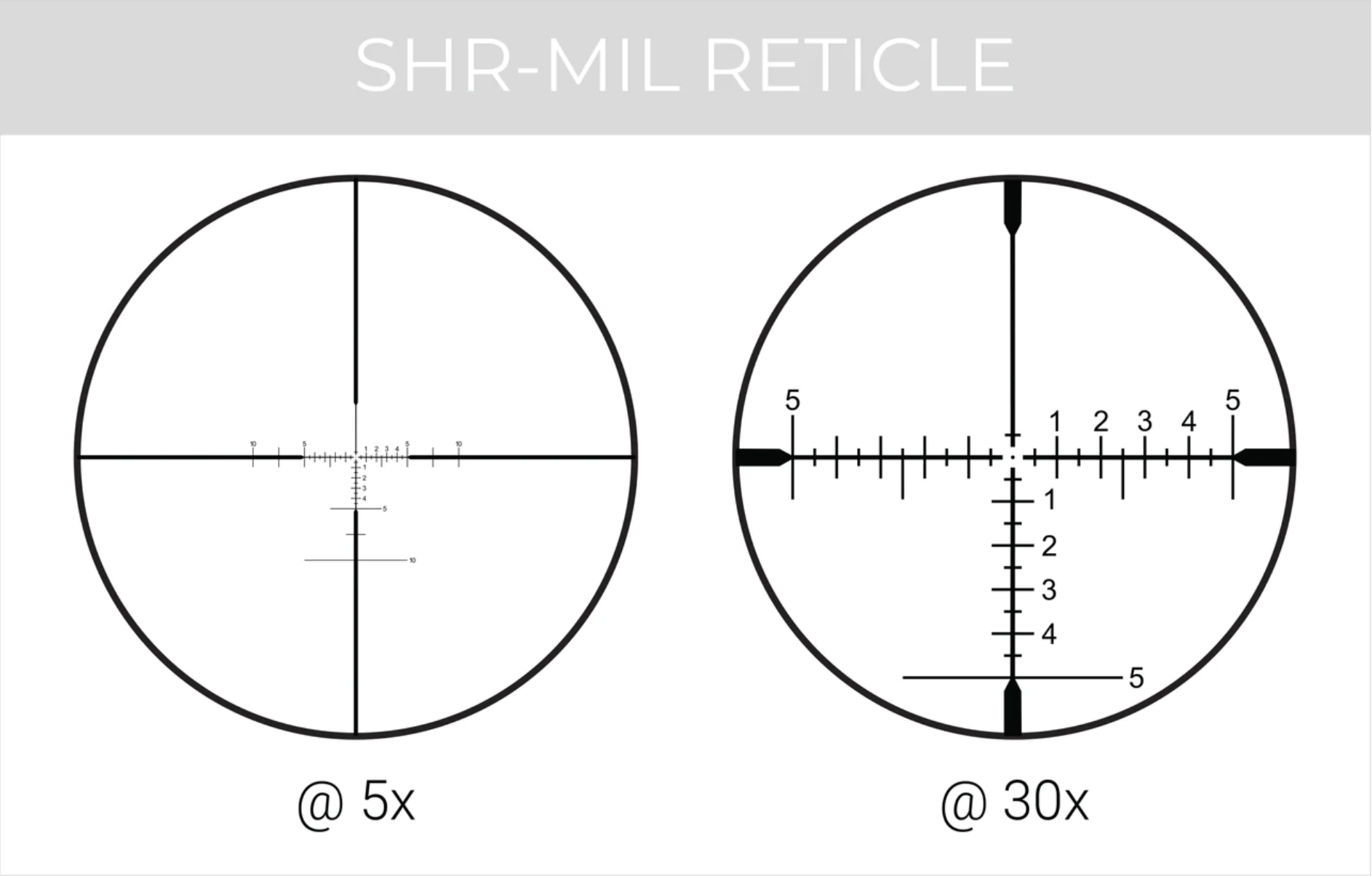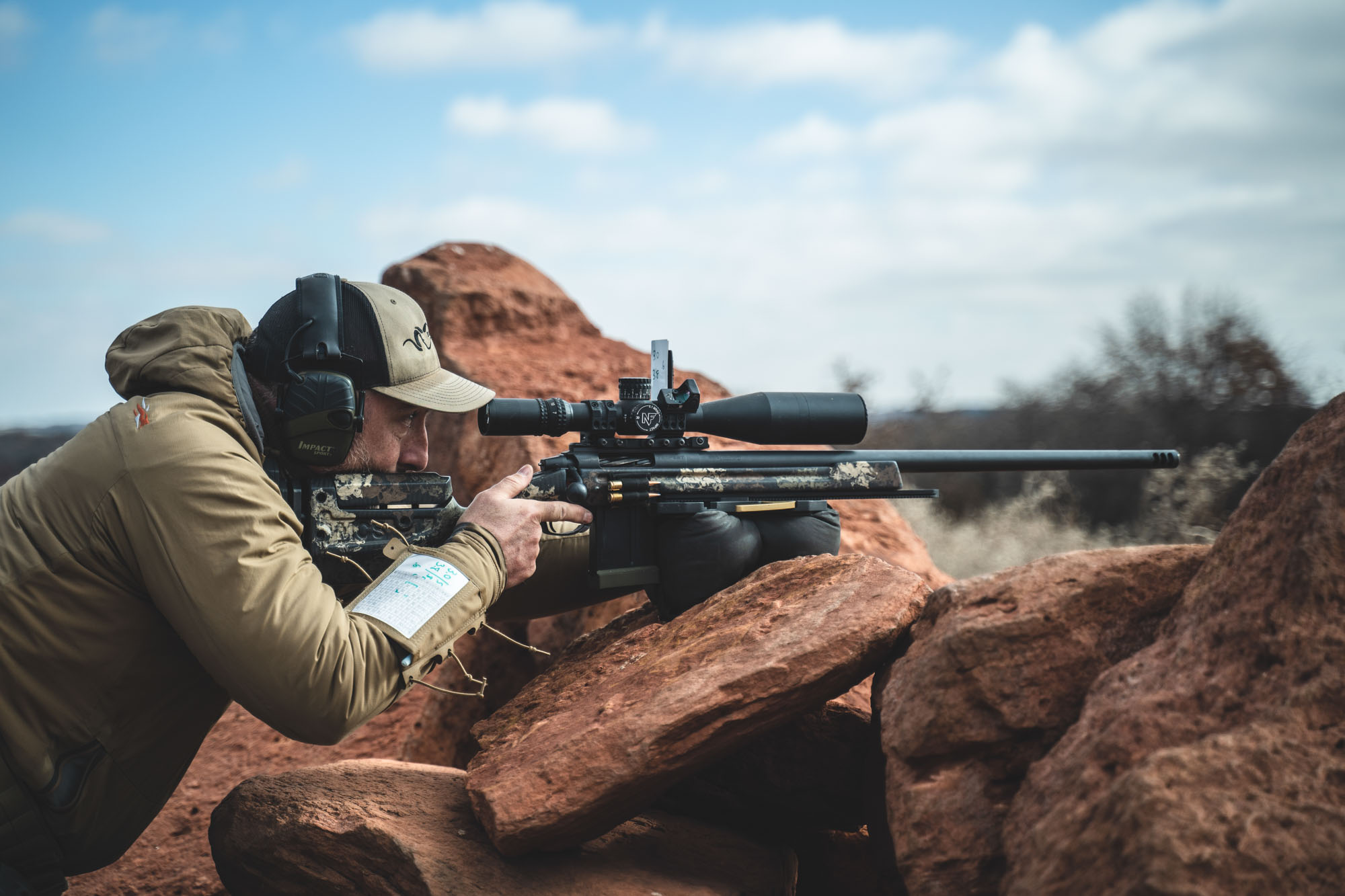We may earn revenue from the products available on this page and participate in affiliate programs. Learn More ›
Are you going to buy that rifle scope in MIL or M.O.A.? That’s by far the most common question you’ll get at sporting goods stores, big-box retailers, and online optics sites, but even though they know it’s coming, many shooters freeze up when asked. What’s the difference between MIL vs MOA again?
It’s the difference between Catholicism and Lutheranism. Practitioners of both believe in the same God, but they differ in important matters of semantics and ritual. It’s the distinction made by tequila drinkers versus agave drinkers. Their beverages of choice are closely related, but each hits a little different. It’s the difference between yards and meters.
Ten years ago, the distinction between MOA and MIL didn’t make such a difference, because both were secondary to a more common rifle scope design, one built on ¼-inch turret adjustments and second-plane reticles with few holdover marks or windage references. Long-distance precision rifle shooters had strong, almost religious, feelings about this MOA vs MIL distinction, but at the time these were small communities whose members hadn’t yet influenced the design of the best-selling scopes, which were mainly intended for mid-range deer hunting.
The story of rifle scope design over the past decade has been just how influential those precision shooters have become, to the degree that nearly every scope produced in the past few years, whether for target shooting or for hunting, is configured with either MOA (minute of angle) or MIL (milliradian) turret and reticle references. What’s more, these aren’t just set-it-and-forget-it scope controls. Most scopes now on the market have aiming adjustments that are designed to be dialed or held over or off the target to accommodate for wild variations in range, wind, shot angle, and bullet trajectory.
While some scope lines are built with only MOA or only MIL adjustments, most brands make their most popular models with both. Which brings us back to the initial question: Are you going to buy that scope in MOA or MIL?
We’ll detail the types of scopes where this distinction really matters in a bit, but first, relax. There’s not nearly as much difference between these two systems as their most rabid adherents want you to believe. Both are expressions of precision – they’re both measurements of a portion of a circle – and there are both important and unimportant trade-offs to both. The main thing is that they’re tribal designations that may not shake one’s belief in God, but offer important insights into a shooter’s preference, background, and style.
Not to distract from these distinctions, but there are plenty of other elements to consider when buying a scope, including the quality of its glass, its magnification and reticle location, the repeatable precision of its controls, its cost, and whether the brand has a good warranty. But after you’ve settled on each of a scope’s other attributes, you’re going to have to answer that MIL vs MOA question.
While many shooters are capable with both systems, most increasingly gravitate toward one or the other. This is a gross generalization, but shooters who mainly hunt with their scopes are generally more comfortable with MOA adjustments. Shooters who mainly shoot precision targets—whether long-range steel with center-fires or precision rimfire matches—are increasingly likely to demand a MIL-based scope.
Where it’s really important is when you shoot with a partner. Say you’re spotting the hits of your buddy who is shooting a MIL-based scope, but you view the world only in MOA. You’re going to waste precious time, and risk miscommunicating, because you’re essentially speaking two different languages when you talk about holds. This is one reason that MIL-based scopes are taking over precision target competitions; when everyone speaks the same language, the risk of losing important details in translation is minimized.
The Difference Between MOA and MIL
The most useful way to understand distinctions between the two aiming systems is to consider the difference between Imperial and metric measurement.
Understanding MOA

Most Americans grew up measuring their world in inches and yards. Those are Imperial standards of distance that confuse the rest of the world because of their arbitrary, fractional nature. An inch is 1/36th of a yard? And there are 1,760 yards in a mile? How does that make sense?
The Imperial method of measuring angles, based on the fractions of a circle that we call degrees, is equally arbitrary. A minute of angle is 1/60th (one minute) of a degree. You can see how unwieldy this is when you start to divide: 360/60 = .016667th of a circle. Now multiply. A circle contains approximately 21,600 minutes of angle.
Understand MIL

The metric system is far easier to understand, because it’s based on units of 10. A centimeter is 1/100th of a meter. A kilometer is 1,000 meters. Similarly, a MIL is 1/1,000 of a radian. If you recall your high-school geometry, the way to calculate the number of radians per circle (circumference) is to double pi, or 2×3.14159 = 6.2831. If you want to calculate the number of milliradians per circle, just divide by 1,000, which gives us 6,283 MILS per circle.
Slices of the Same Pizza
Both MOAs and MILs are angular measurements. Picture a triangular slice of pizza. The angle from the point to both ends of the crust is a constant; it doesn’t change on that particular slice of pie, and extends from the point of the slice all the way out to infinity. For shooters who engage targets anywhere from 34 yards out to 2,000 yards (or, um, meters), expressing holds in MILs or MOA is much more useful than in inches, since 10 inches at 100 yards is a far larger fraction than 10 inches at 1,000 yards.
Again, these are useful abstractions to keep in mind as you think about MOA and MIL increments on a scope. The reality is that the math tends to exasperate and intimidate most shooters, who instead of trying to figure out how to adjust their aim using their scope’s references instead default to the old set-it-and-forget-it style of close-enough shooting.
But knowing how your turret and reticle work, both together and independently of each other, is key to becoming a competent shooter, whether you aim at paper or pronghorns, and it’s key to squeezing the full capability out of your new scope. So here are a few shortcuts to help you decide whether MOA or MIL is the best for you, and then how to understand each.
Do You Think in Yards or Meters?
That question – do you think in inches and yards or in centimeters and meters? – is a useful demarcation between MOA and MIL shooters.
Most MOA shooters tend to describe distances in yards and miles. Remember I mentioned that MOA shooters often grew up hunting, as opposed to target shooting. Given that background, measuring their scope turret click values in ¼ inches and targets in 100s of yards, MOA increments are more familiar. That is, these shooters can better visualize holdover and hold-off because they’re more familiar with the units of measure.
One reason MIL-based scopes took off in the precision-target world is because military snipers and combat shooters were trained to view the world and to think in terms of meters, and these veterans were early adopters of civilian PRS competitions and the big precision scopes used to ring distant steel. These shooters are accustomed to the quick, on-the-fly calculations that use the base-10 math of the metric system. And they’re used to thinking of measurements in centimeters, meters, and milliradians.
Do You Hold or Dial?
In true MIL/MIL and MOA/MOA configurations, in which the turret values are tuned to the same scale and increments as reticle references, holding your turret 10 MILs over the target should give you the same bullet impact as if you dialed 10 MILs of elevation. Same with matching hold-off (either left or right of center) with your windage turret corrections.
In reality, many shooters employ a combination of holding and dialing. A favorite method is to dial for elevation and hold for wind. In either case, dialing is typically faster and more sure with MIL-based systems. It’s faster, because the .1 MIL turret click values move the reticle more quickly than the finer .25 MOA increments. And because 1/10th MIL values are expressed in a single digit (.1, .3, etc.), the turret indexing is cleaner and clearer than the two-digit values expressed by the ¼ MOA (.25, .40, .75, etc.).
Similarly, MIL-based reticles, which generally have references in ¼ MIL values, are cleaner and less cluttered than MOA-based reticles, which have elevation and windage references in .5 or 1 MOA increments. The finer scale of the MOA system means these reticles can be busy and require time (and good eyes) to count dots and hashes to establish the units of measurement. In scopes with sub-par optics and imprecise reticle etching, these fine lines can be especially difficult to see.
MIL vs MOA In Precision Scopes

This will stir up some readers, but I maintain the distinction of MOA vs MIL is overstated in many dedicated precision rifle scopes. I’m talking about those scopes with big, tactical-style turrets and first-plane reticles with what are called “Christmas tree” designs that have cascading elevation and windage references. Examples are the Tremor reticles from Horus, Zeiss’s ZF-MRi, or Trijicon’s MRAD Precision Tree.
It’s a useless distinction a) because these serious precision shooters have long ago aligned with either the MOA or the MIL view of the world, and they’re capably ringing steel with the scope that matches their preference. And b) because these scopes have such granular aiming references, once you comprehend the system, hitting targets is largely a matter of following a recipe. Target is 8.6 MILs (29.6 MOA) up and wind hold is 2.1 MILs (7.2 MOA) right. You can either dial the turrets or hold the reticle to make the hit.
But even in this world of shooters who understand both MOA and MIL systems well, you’ll hear some frequent digs at both systems. Some MIL shooters feel that the MOA nomenclature is too granular, and therefore slow, especially in the heat of competition when the scale of the MOA system is distractingly fine. Some MOA shooters feel the MIL system doesn’t provide enough precision, and they say they’re often forced to hold between cardinal references, especially at high powers when the reticle references grow in proportion to the magnification. And some shooters have correctly recognized that manufacturers haven’t developed the precision to mill true MOA turrets; instead, some scopes use inches-at-1,000-yards as their turret values, but label them MOA.
The problem with this variation between inches-at-1,000-yards vs true MOA values is negligible at deer-hunting distances. But because an MOA value is slightly fat (1.047 inches) compared with an inch at 100 yards, the variation increases with distance, to the degree that mis-labeled turrets could be off nearly 5 inches at 1,000 yards, and closer to 20 inches at 2,000 yards. That’s the difference between a hit and a head-scratching miss.
Those are all perspectives of reticles as aiming devices. But first-plane reticles are also used as measuring devices. Not sure of the distance of a steel plate, but you know it’s 8 inches wide? You can use your reticle to measure its width in either MILs or MOA, and based on the reticle references get pretty close in terms of range. Knowing that one MIL covers 36 inches at 1,000 yards is a good starting point for using your reticle to estimate range. Generally speaking, the MIL system’s base-10 system is easier to extrapolate with in the field compared to the complicated fractional math of the MOA system.
MOA vs MIL in Hunting Scopes

As we’ve reported, a number of manufacturers are producing cross-over scopes, optics that have simplified first-plane reticles with references on the horizontal and vertical stadia but no holdover or hold-off references out in the field of view.
The idea for these hybrid scopes is that they offer a bold crosshair aiming point for traditional set-it-and-forget-it hunters and shooters, but they have useful references for hunters and shooters who want to hold over (for elevation) or hold off (for windage). And many of these scopes have precise turrets with excellent indexing and zero stops for those shooters who want to dial an aiming solution.
Customers shopping for these scopes, which range from Maven’s RS3.2 to Leupold’s Mark5HD to the Trijicon Tenmile HX, will be asked that common refrain: MOA or MIL?
In these scopes, I’d argue that MIL is the better configuration. The reason is ease of operation. The MIL system gives you fewer, but I’d argue faster and more versatile, elevation and windage holds. Conversely, many of the MOA-based systems have references with confusing values (some are 2 MOA, others 2.5 MOA, and still others .5 or even .33 MOA).
Many of these advanced first-plane duplex reticles are built on the tried-and-true Mil-Dot system, in which .25 MIL dots are placed along each axis. Once you get used to both aiming and ranging with these dots, you can make precise shots quickly, regardless of magnification. And for those who would rather dial, most of these new versatile scopes feature excellent turrets with clear indexing and easy return-to-zero features.
Read Next: FFP vs SFP
Final Thoughts on MIL vs MOA
At the end of the day, both MOA and MIL systems will perform as well as the shooter. The biggest determinant of their success is your willingness to learn not only the systems, but how each is deployed by your specific scope.
The configuration of your scope is just the starting point. The second element is your specific bullet and load, and how it performs in your rifle. You’re going to want to build a range card that provides field-proven aiming references, both elevation and wind, at known distances. Consider this a cheat sheet that can get you close when you shoot at unknown distances. The fun part of shooting is using your scope’s references, your experience, and your understanding of your aiming system to go from close-enough to one-shot hits.
The last variable to consider is situational. How does the combination of the scope and the load perform in the real world, with wind and elevation, and mirages, and moving targets, and time constraints?
Good shooters will perform well regardless of the system — MOA or MIL — they employ, just as short-cutting shooters will struggle with either system.

